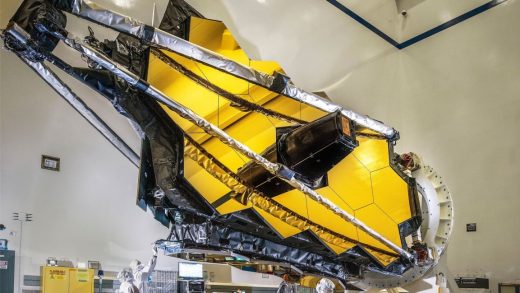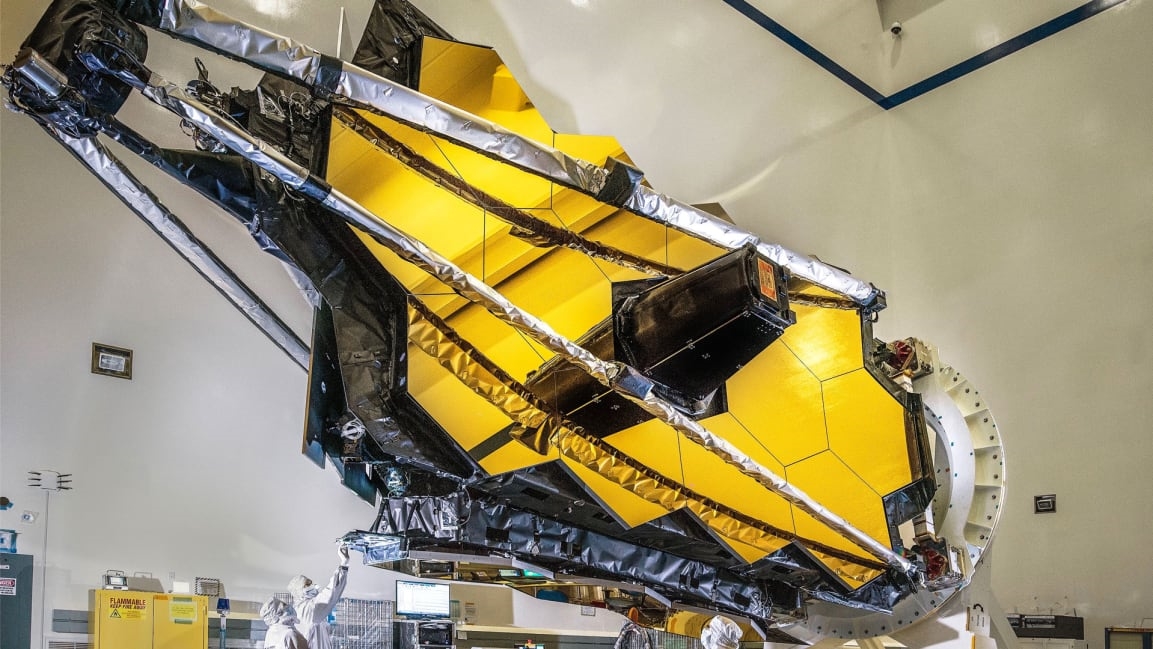NASA’s amazing space telescope will peer 13.5 billion years into the past
It’s a sight out of a science-fiction novel—a soaring tower of hexagonal gold mirrors atop a massive five-layered silver sunshield and a circular spacecraft bus. Polished to within nanometers of accuracy, the mirrors front a quartet of complex instruments sensitive enough to decipher alien atmospheres and peer back to the dawn of time.
Since the last of the completed components arrived from NASA bases around the country last August, the 14,000-lb. James Webb Space Telescope (JWST) has come together in a cavernous clean room at Northrop Grumman Space Park in Redondo Beach, California. From the vantage of the observation deck, the only indication of its four-story height are miniature engineers clad in white jumpsuits scurrying about its base. This is the first time that press—invited late last month for a briefing on the mission’s next steps—have seen the fully assembled observatory.
“Over the last few years, we were working in two halves. Until the summer of last year, they were in a very long engagement, and they got married,” laughs Scott Willoughby, JWST program manager at Northrop Grumman. “We put the two halves together to create an observatory. We’re celebrating that success.”
After 24 years and numerous delays, the $9.6 billion mission is entering its final year of tweaks and tests before the telescope is shipped to the Guiana Space Center in French Guiana for a March, 2021 launch. The journey has engaged thousands of scientists and engineers from 24 countries in three space agencies—NASA, the Canadian Space Agency, and the European Space Agency. It was built in several facilities across the U.S., with the focus of activities at Northrop Grumman and the Goddard Space Flight Center in Greenbelt, Maryland.
Orbiting 1 million miles from Earth, JWST will peer some 13.7 billion years into the past, a split-second (or 100 million years from Earth’s coordinates) after the Big Bang, as the universe transitioned from a dark plasma state to forming the first light, stars, and galaxies. It will also analyze the atmospheric composition of smaller rocky exoplanets orbiting other stars to determine their hospitality to life.
“Where do we come from and are we alone, is the overarching mission,” says Willoughby. “We’ve never seen a star formed that wasn’t a product of an exploded star. What made the ‘lumpiness’ come together and ignite the first stars? Every time you think you know something, you want to prove it out, to actually see how it happens.”
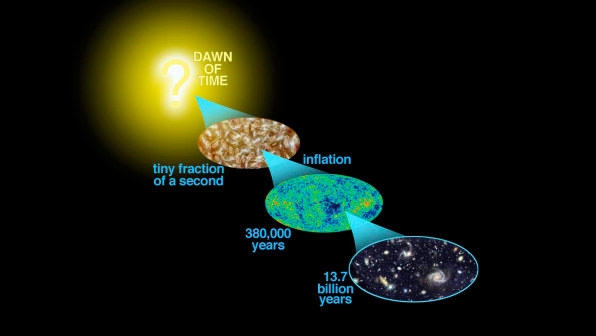
In the beginning, the infant universe was mostly hydrogen and helium—before eons of solar fusion produced the abundance of other elements found today. Stars were 300 times larger than the Sun and lived just a few million years before dying in giant supernovas. The telescope is designed to capture traces of infrared light from these explosions, that, when analyzed, will tell scientists what they were made of and the environments in which they were formed. It’s the next chapter of the universe after measuring the cosmic heat from the Big Bang, which earned John Mather and George Smoot the Nobel Prize in physics in 2006.
“Where does light come from? How did we get from the Big Bang to us?” says Mather, JWST’s senior project scientist at Goddard. “People are fascinated by history, their genealogy. They want to know, ‘Where are we going?’ So this is our little bit to find out some of it.”
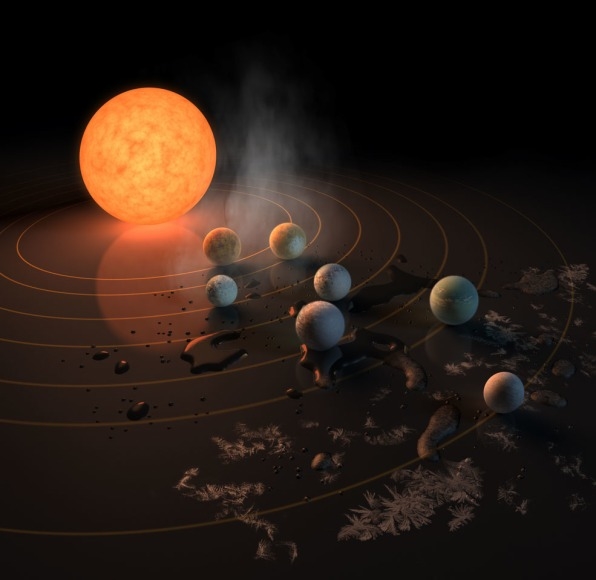
[Image: NASA and JPL/Caltech]
On a grand scale, finding Earth-like worlds is the first step toward ensuring human survival after our sun dies in 5 billion years—if we don’t do ourselves in first. More immediately, it may offer clues to our earthly origins and changing habitat.
“One way to better understand Earth is to find other places and figure out how they worked,” says Mather. “We still are able to find traces of our geological history, but that only tells you one story. So if you could say, ‘What was Venus like before it became a hothouse?’ or ‘What was Mars like before it dried out?’ Then it would give you some hint as to what you might need to do here on Earth to preserve the environment. These other places are a miniature laboratory for understanding.”
Unprecedented challenges
When engineers began considering the JWST in 1996, they needed 10 technologies that didn’t yet exist. Those included a 21.3-foot diameter mirror that had to be broken up into 18 individual parts but work as a unit, and five tennis court-size sunshields to block the sun’s radiation and cool the telescope temperature down to -388°F. The assemblage in its entirety had to fold up to fit inside a 16-foot diameter Ariane rocket fairing and be programmed to unfurl a million miles away. It also required a new generation of detectors more sensitive than previous ones.
Much more scientific investigating can get done in less time.”
Bill Ochs, Goddard Space Flight Center
Observing objects from billions of light years away requires a mirror large enough to gather light from very faint objects. The JWST mirror is the size of seven Hubble Space Telescope mirrors and will see objects hundreds of times fainter than current ground and space telescopes.
“Hubble was 25,000 pounds and had one 2.4 meter (7.87 ft.) optic. The Webb is 14,000 pounds for a 6-and-a-half-meter (21.3 ft.) optic,” says Willoughby. “So we grew the optic by seven times the collecting area, with half the weight, that fit into the rocket.”
Instead of much heavier glass, the mirror is made of beryllium, a rare metal that is stronger than steel but lighter than aluminum. It’s then coated in a microscopically thin layer of 24K gold, which reflects 98% of infrared light. “It’s a couple of wedding bands’ worth of gold,” says Bill Ochs, JWST project manager at Goddard.
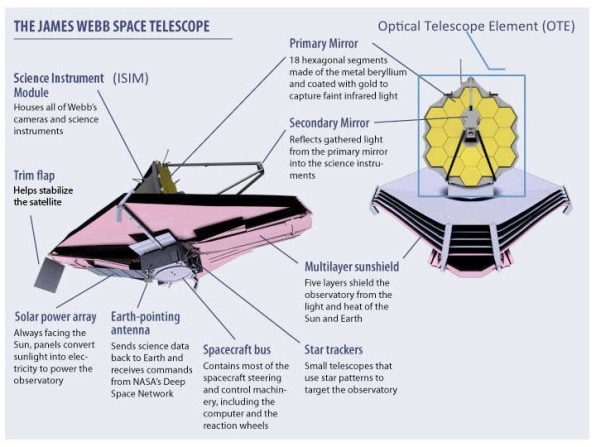
The primary mirror focuses the infrared light onto the secondary mirror, which beams it back to four scientific instruments behind the mirror analyzing the range of infrared wavelengths, digitizing the information, and beaming it back to Earth. One of those instruments, the Near-Infrared Spectrograph, sports thousands of specially designed programmable microshutters, with apertures the size of a few human hairs. The shutters can better lessen the volume of incoming light and accomplish simultaneous observations.
“Other spectroscopic instruments have flown in space before, but none have had the capability to enable high-resolution observation of up to 100 objects simultaneously,” says Ochs. “That means much more scientific investigating can get done in less time.”
Keeping it cool
JWST instruments will measure the near to mid-infrared spectrum, where wavelengths run .6 to 28 microns, respectively bordering the color red and microwaves. Infrared enables us to see farther into the universe (thus, farther back in time), because the universe is expanding, creating a redshift effect. Objects moving away from us emit longer electromagnetic wavelengths that appear in the red and infrared part of the spectrum.
To determine the chemical compositions of exoplanet atmospheres, onboard spectrographs will measure infrared light fluctuations—corresponding to different elements—from parent stars as their planets traverse their paths.
Since infrared cameras are more sensitive to radiation (i.e., light and heat), the telescope has to be far enough away from the sun and its reflected light on the Earth and moon, and have a shield that blocks the sun’s rays and keeps the telescope cold enough to avoid interference from infrared radiation coming from the telescope.
“On the cold side, the optics run at -388°F, because that’s where they’re collecting the infrared light,” says Willoughby. “The hot side, where the bus is and the Sun is shining, reaches 185°F. So we create almost a 600°F-differential. And the fun stat is, if that was sunscreen, it would be a 1 million SPF.”
A cryocooler further cools the science instruments to -448°F. “Those detectors are so sensitive, we actually have to get it colder than what we can do passively,” says Ochs.
Bunny suit required
Like the Mars 2020 rover, the JWST build requires the pristine conditions of a particulate-free clean room. Engineers wear “bunny suits”—white polyester jumpsuits, booties, hoods, surgical masks, and latex gloves. The mirrors have been polished to within 20 nanometers of surface figure accuracy, smaller than the size of a single bacterium. “The surface is so smooth because any bump would cause a photon to veer off in a different direction,” says Willoughby. “You have to worry about every speck of dust, what people wear, and even colognes and perfumes. The fact that you can smell them means they’re giving off atoms and molecules. We don’t want those molecules attaching to the sunshield or the mirrors.”
With the last of the thermal tests completed—subjecting the optic, shield, and bus to temperature extremes—the biggest challenge in the past year has been joining the optics with the sunshield. Though it took just a day to accomplish, it’s the result of years of planning and practice.
“We have engineers that just built equipment that helped deploy things,” says Willoughby. “It turns out their job is every bit as hard as building the thing that goes into space.”
Gravity is probably our toughest thing we deal with right now.”
Northrop Grumman’s Scott Willoughby
Part of the challenge was replicating weightlessness or accounting for gravity. Once in orbit, the optic and sunshield will separate 4 feet to allow the shield to deploy. But joining them on Earth involved placing 8,000 pounds of telescope on six posts atop the shields. They were able to simulate within 70 pounds of zero gravity through a complex dance of motors, ceiling pulleys, and wall counterbalance weights.
“Gravity is probably our toughest thing we deal with right now,” says Willoughby. “In space, it’s going to float in zero G. So when we were landing the optic on top, it had to touch the corners of the 6 feet and be positioned to within .004 of an inch. And once you get outside of three, it’s hard to make a plane.”
The team practiced for half a year with models and laser trackers before attempting it with the real deal. “That’s probably one of the most complicated deployments we did,” he adds. “It was perfect. It was actually beautiful.”
The year ahead
During the next year, teams will administer some 400 tasks before leaving the clean room. They include checking the deployments of the optic and sunshield, running the observatory through electrical and environmental inspections, and simulating the acoustics and vibrations of the launch and spaceflight. From there, the JWST will make the two-week trip through the Panama Canal to the launch site, encased in an environmentally controlled container. Once there, engineers will spend 72 days conducting another 800 tasks before it finally blasts off. (Launching near the equator harnesses the momentum of Earth’s spin to help catapult it into space, thus requiring less rocket fuel.)
Meanwhile, the Space Telescope Science Institute (STSI) at Johns Hopkins University in Baltimore, the operations center for the JWST, has been lining up the astronomy to be studied. With the observatory’s first six months already scheduled, the STSI will fill the remainder of her first year by choosing from an anticipated 1,500 science proposals. The Institute will issue requests for new proposals annually, and archive incoming images for the respective science teams.
Not all JWST discoveries lie in the future. Some of its technology has already found earthbound applications. For example, a focusing mechanism in ophthalmic microscopes was invented by engineers devising the telescope mirrors. “So there’s a connection that you never see,” says Mather.
Once in orbit
It will take nearly three weeks for the craft to reach orbit—a position called the second Lagrangian point, or L2—where combined gravitational forces of the Earth and sun enable an object there to rotate the sun at the same pace as Earth. While en route, ground controllers will order the 178 devices that hold it together for launch to open and begin the probe’s programmed deployment.
“Those of you who covered the Mars lander where they said they had the ‘seven and a half minutes of terror’?” says Ochs, referencing Curiosity’s dramatic teaser video. “I jokingly referred to this as ‘two and a half weeks of high anxiety.’”
Once in orbit, and over the ensuing six months, roughly 500 different activities will engage across the spacecraft, science instruments, and telescope to make it operational. And then, the science can begin.
Ultimately, the JWST will carry enough hydrazine fuel to keep it functioning for up to 14 years with careful management. A team at Goddard is working on a robotic refueling mission that could further extend the observatory’s life.
“This is a really exciting period of time because everything’s coming together,” says Ochs. “We’re looking forward to launching the science. All these people have been working together for this period of time. I have folks working for me who started when their kids were little and now those kids are graduating from college.”
Fast Company , Read Full Story
(57)

